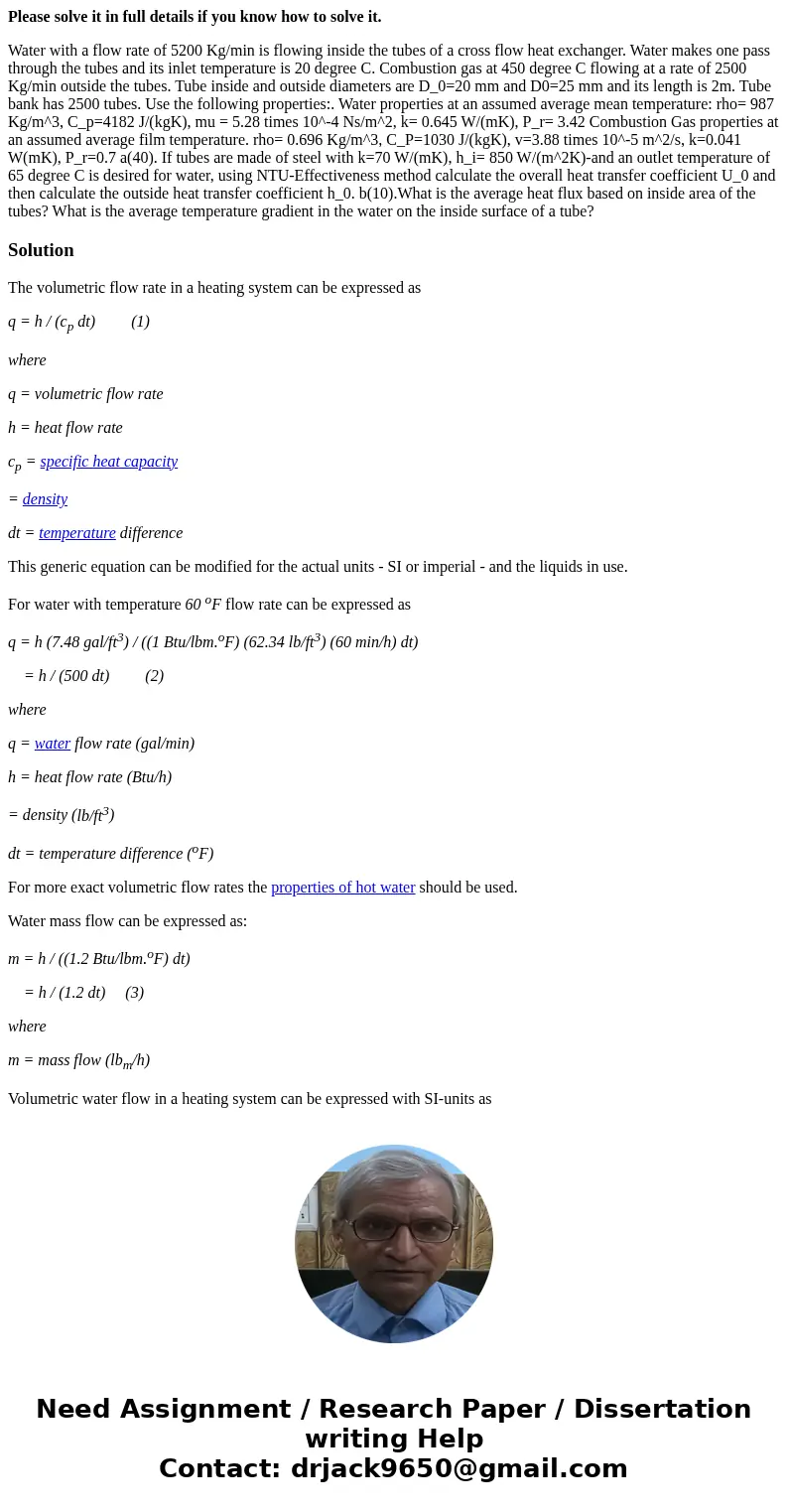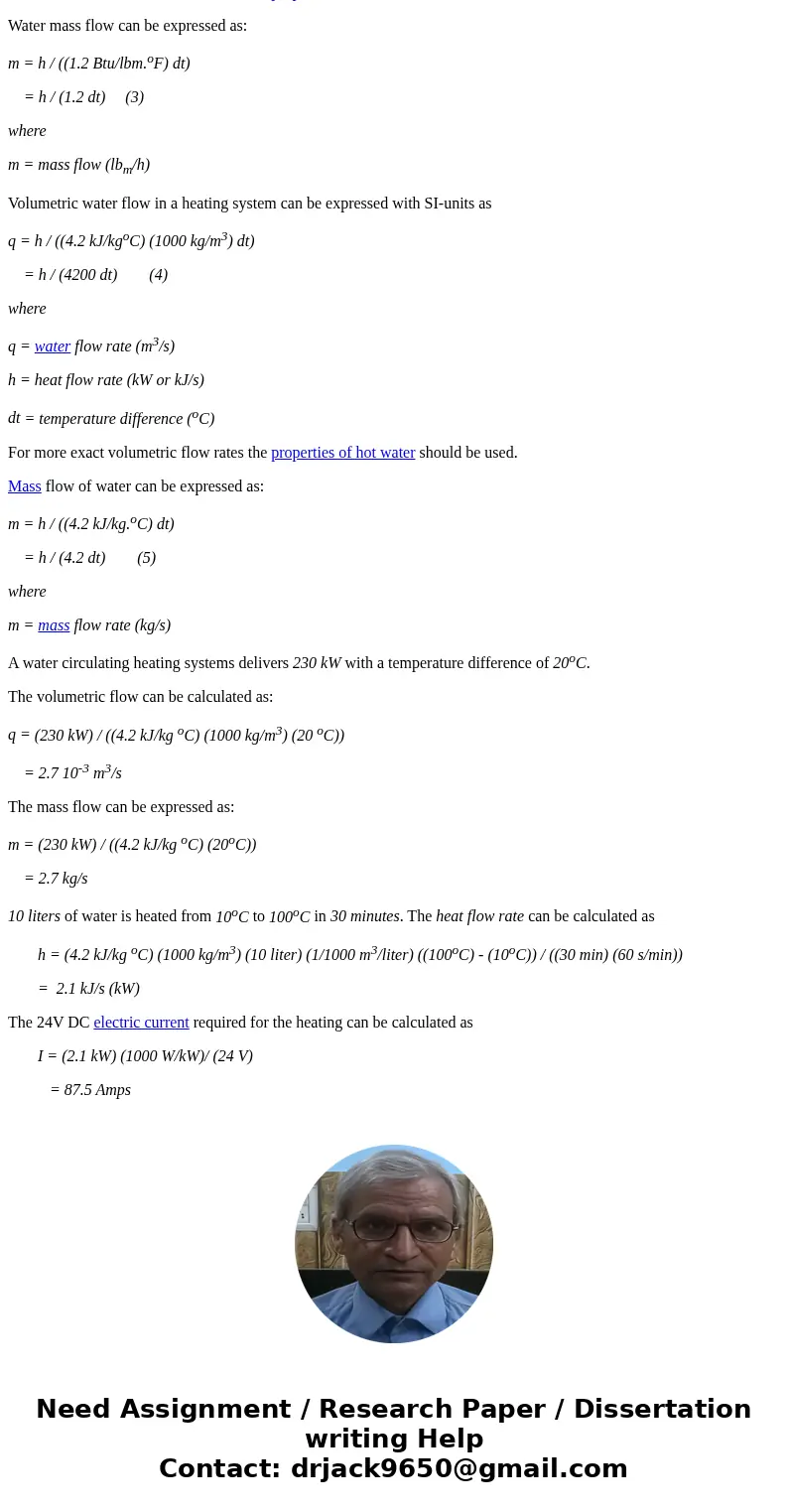Please solve it in full details if you know how to solve it
Please solve it in full details if you know how to solve it.
Water with a flow rate of 5200 Kg/min is flowing inside the tubes of a cross flow heat exchanger. Water makes one pass through the tubes and its inlet temperature is 20 degree C. Combustion gas at 450 degree C flowing at a rate of 2500 Kg/min outside the tubes. Tube inside and outside diameters are D_0=20 mm and D0=25 mm and its length is 2m. Tube bank has 2500 tubes. Use the following properties:. Water properties at an assumed average mean temperature: rho= 987 Kg/m^3, C_p=4182 J/(kgK), mu = 5.28 times 10^-4 Ns/m^2, k= 0.645 W/(mK), P_r= 3.42 Combustion Gas properties at an assumed average film temperature. rho= 0.696 Kg/m^3, C_P=1030 J/(kgK), v=3.88 times 10^-5 m^2/s, k=0.041 W(mK), P_r=0.7 a(40). If tubes are made of steel with k=70 W/(mK), h_i= 850 W/(m^2K)-and an outlet temperature of 65 degree C is desired for water, using NTU-Effectiveness method calculate the overall heat transfer coefficient U_0 and then calculate the outside heat transfer coefficient h_0. b(10).What is the average heat flux based on inside area of the tubes? What is the average temperature gradient in the water on the inside surface of a tube?Solution
The volumetric flow rate in a heating system can be expressed as
q = h / (cp dt) (1)
where
q = volumetric flow rate
h = heat flow rate
= density
dt = temperature difference
This generic equation can be modified for the actual units - SI or imperial - and the liquids in use.
For water with temperature 60 oF flow rate can be expressed as
q = h (7.48 gal/ft3) / ((1 Btu/lbm.oF) (62.34 lb/ft3) (60 min/h) dt)
= h / (500 dt) (2)
where
q = water flow rate (gal/min)
h = heat flow rate (Btu/h)
= density (lb/ft3)
dt = temperature difference (oF)
For more exact volumetric flow rates the properties of hot water should be used.
Water mass flow can be expressed as:
m = h / ((1.2 Btu/lbm.oF) dt)
= h / (1.2 dt) (3)
where
m = mass flow (lbm/h)
Volumetric water flow in a heating system can be expressed with SI-units as
q = h / ((4.2 kJ/kgoC) (1000 kg/m3) dt)
= h / (4200 dt) (4)
where
q = water flow rate (m3/s)
h = heat flow rate (kW or kJ/s)
dt = temperature difference (oC)
For more exact volumetric flow rates the properties of hot water should be used.
Mass flow of water can be expressed as:
m = h / ((4.2 kJ/kg.oC) dt)
= h / (4.2 dt) (5)
where
m = mass flow rate (kg/s)
A water circulating heating systems delivers 230 kW with a temperature difference of 20oC.
The volumetric flow can be calculated as:
q = (230 kW) / ((4.2 kJ/kg oC) (1000 kg/m3) (20 oC))
= 2.7 10-3 m3/s
The mass flow can be expressed as:
m = (230 kW) / ((4.2 kJ/kg oC) (20oC))
= 2.7 kg/s
10 liters of water is heated from 10oC to 100oC in 30 minutes. The heat flow rate can be calculated as
h = (4.2 kJ/kg oC) (1000 kg/m3) (10 liter) (1/1000 m3/liter) ((100oC) - (10oC)) / ((30 min) (60 s/min))
= 2.1 kJ/s (kW)
The 24V DC electric current required for the heating can be calculated as
I = (2.1 kW) (1000 W/kW)/ (24 V)
= 87.5 Amps


 Homework Sourse
Homework Sourse